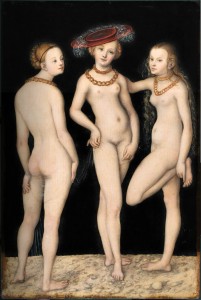The Three Graces, Lucas Cranach the Elder’s 1531 masterpiece, has been in private hands since it was first commissioned. A French family has owned it since 1932, but when they sold it this November to a foreign buyer for €4 million ($5.4 million), the French government declared it a “national treasure” (despite its German origin) and gave the Louvre three months to raise the money to buy the 9″ x 12″ oil on wood painting. The museum had €3 million good to go thanks to its acquisition budget and two corporate donors, but to raise the last million the Louvre launched a fundraising campaign.
Although this sort of campaign is fairly common in the US and the UK (the Staffordshire Hoard campaign, for example), France’s tradition of state-sponsored art goes back to Louis XIV, so it is not accustomed to having to make public appeals for donations to purchase historical and artistic masterpieces. There was some grumbling in the press, but the discontent was not widespread enough to interfere with the campaign.
 Donations from €1 to €40,000 ($52,700) came pouring in from the Louvre’s fundraising website and the shortfall was overcome in just one month. Most of the 5,000 donors were on the low end of that scale, with the average gift being €150 ($195) and fully a quarter of the donations hovering around the €50 ($65) mark. Donors ranged in age from eight to 96, and a quarter of the donations were dedications, some in memory of a loved one, some in the name of a newborn, some to a living person, some in honor of a special event.
Donations from €1 to €40,000 ($52,700) came pouring in from the Louvre’s fundraising website and the shortfall was overcome in just one month. Most of the 5,000 donors were on the low end of that scale, with the average gift being €150 ($195) and fully a quarter of the donations hovering around the €50 ($65) mark. Donors ranged in age from eight to 96, and a quarter of the donations were dedications, some in memory of a loved one, some in the name of a newborn, some to a living person, some in honor of a special event.
The names of all 5,000 donors will be listed in a special exhibition room where the painting will be on display from March 2 to April 4. Donors who gave €200 ($270) will be be invited to a special viewing of the work and donors who gave €500 ($680) will be invited to a special preview before the painting is put on public display. Remember, this painting has always been in private collections, so this exhibit will be the first time the wider public has a chance to see this The Three Graces.
From the Louvre’s website:
The Three Graces is a theme that dates back to Antiquity. It has spun off into a number of mythological variants, but they often personify mirth, abundance and splendor. Artists have often revisited this theme throughout history, right up to the present day.
Lucas Cranach’s art intertwines the realism cherished by Northern European painters and the softer, smoother style verging on the imaginary realm of Italian paintings, with a very personal, strange and deliberately ironic version.
For a Renaissance artist, painting the Three Graces first of all entailed broaching the notion of depicting female nudes. And Lucas Cranach’s take is brimming with virtuosity and a deeply original way of depicting the female form. He shows his ability to use his brush to draw the silky texture of the flesh, the elegance of the faces, and the graceful, flowing sensuality of the bodies. There is something disconcertingly erotic about these female nudes (Lucas Cranach was a master of this discipline, and indeed built his reputation on it). The Three Graces crowns this artist’s musings on other figures such as Eve or Venus. The landscapes that provide the backdrop for those compositions, however, have vanished and the plain dark background in their place brings out the intensity of the flesh and the objects in the painting.
Cranach worked on every detail in this painting with exquisite finesse: the eyes, the elegant noses, the position of the chignons, the pinkish cheeks and the delicate work on the hands.
Each of the Graces has its own distinctive movement, which affords each of them their own independence and sensuality. Their postures radiate extraordinary freedom, and are eminently modern: the one on the left is turning her back and clutching her thigh; the one on the right is facing sideways, standing on her right leg and holding her left ankle with her left hand; the third is the only one facing us, and wears an elegant hat. An extraordinarily ethereal and transparent haze intensifies the seductive aura and underlines the three young women’s nudity.
Cranach’s flair in creating a scene that is at once lively and harmonious is one of the reasons why this painting is considered one of his masterpieces.